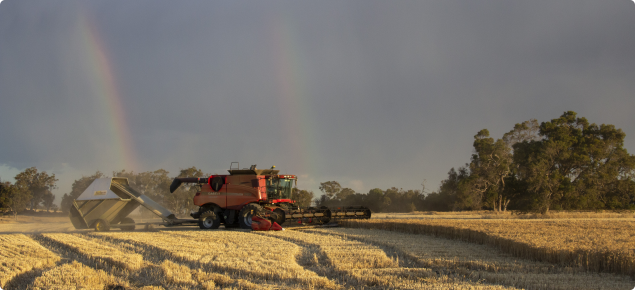Western Australia’s (WA) grains industry faces increasing pressure to reduce its carbon emissions to help meet Australian reduction targets of 43% by 2030.
International shipping, food and feed supply chains have started to assess and reduce emissions at all stages of the supply chain. Sustainability and carbon accountability under schemes such as the International Sustainability and Carbon Certification (ISCC) is becoming increasingly important for major export grain customers. It is also likely that evidence of carbon emission reduction measures and climate resilience will become a lending requirement by the Australian financial sector and part of standard farm business financial reviews.
However, the measurement of farm-level Greenhouse Gas (GHG) emissions is not standardised. Understanding farm baseline emissions will also provide better investment insight into any new income diversification and additional environmental activities such as carbon and biodiversity farming projects.
Project background
The Carbon Neutral Grain Pilot project is an important first step in understanding how to achieve a low-carbon future for WA grain growers.
The project collected GHG emissions data over the 2020/2021 period from 36 cropping enterprises growing wheat, barley, canola, oats and lupins located in four port zones and the wheatbelt regions. The project covered 152,000 hectares and 417,000 tonnes of grain in total.
A broad range of supply chain stakeholders contributed to the project including growers, several self-identified ‘regenerative’ growers, corporate croppers, farm business advisors, banks, fertiliser companies, Meat & Livestock Australia (MLA), Grains Research and Development Corporation (GRDC) and DPIRD. The project has produced baseline emissions data and compared GHG calculators so that grain growers and industry can confidently assess their on-farm carbon footprint.
Project findings
Emissions are classified as Scope 1, 2 and 3.
The project found that more than 70% of all GHG emissions are from Scope 1 on-farm operations sources. Fertiliser and crop residue contribute more than 50% of these emissions.
The other emissions come from Scope 3 pre-farm sources and 95% of these emissions are generated during the production of fertilisers and herbicides/pesticides used on-farm.
Scope 2 emissions were negligible at the on-farm stage of crop production.
Emissions intensity
GHG emissions intensity is a measure of the amount of GHG emissions per tonne of product. It provides a valuable productivity, efficiency and investment measure for farm management decisions.
The project found that wheat, barley, lupins and oats emit between 219 and 242kg CO2-e per tonne of grain, whereas canola emits more than double this, at 551kg CO2-e per tonne of grain. This is mainly due to higher fertiliser inputs and lower yields.
Emissions calculators
With the help of the calculator developers, the pilot assessed the three leading online on-farm GHG emissions calculators for Scope 1, 2 and 3 emissions:
- PICCC Grains-GAF – is produced by thePrimary Industries Climate Challenges Centreat the University of Melbourne and wasfound to be the most user-friendly, accurateand reliable measurement mechanism.The calculator is free, easy-to-use, reliable,fully aligned to the International Panelon Climate Change (IPCC) and AustralianNational Greenhouse Gas Inventory (NGGI),and suitable to WA climate conditions. PICCChas additional GHG calculators for livestock.
- CSIRO FarmPrint – is suited to WAconditions and fully aligned with nationaland international regulations. However, it isnot currently publicly available and isunder commercialisation.
- Cool Farm Tool – provides a quick overviewof GHG emissions. However, it is not currentlyaligned to the IPCC or the NGGI. It is alsoNorthern hemisphere-based and therefore any results are not specific to WA conditions.
All three calculators will work out enterprise GHG emissions. It is important to use the calculator that most suits the farm enterprise conditions. Information on the calculators are available from their websites under "Links"
GHG emissions should, however, be measured over at least two years, as emissions fluctuate annually depending on:
- seasonal rainfall
- temperatures
- crop rotation
- yield
- crop residues
- disease
- nitrogen and fertilisermanagement approaches
- lime
- chemical and fuel use.
Cost to offset emissions
In order to give some sense of the relative costs in becoming carbon neutral, the project used a median price for carbon credits of AUD $31.36 per tonne CO2-e (based on prices in May 2022) and found that the average cost to offset the grain emissions is $10.03 per tonne of grain produced or $27.24 per hectare.
Next steps
It is important to understand the significance of life-cycle-analysis GHG emissions for farm enterprises. WA grain growers are encouraged to start using GHG calculators to measure their emissions.
This pilot project has been part of CBH and WOA’s ongoing research into sustainable grain growing and part of the DPIRD Emissions Reduction Program. The research will continue with CBH, WOA, DPIRD, GRDC and other industry partners improving the data sets and analysis and working towards achieving a low-carbon future for WA grain growers.
The full report is available here.
Carbon Neutral Grain Pilot Project Consultants
Project manager: Larissa Taylor, Savoir Consulting
Data analyst: Ben White, BM White Consulting
Data analyst: Richard Brake, Richard Brake Consulting
Contacts
Gus Manatsa
Program Manager, Emissions Program & Sectoral Emissions Reduction Strategy: Agriculture, DPIRD
Gus.Manatsa@dpird.wa.gov.au
Trevor Lucas
Head of Accumulations, CBH Marketing and Trading
Trevor.Lucas@cbh.com.au
Craig Pensini
Impact Coordinator, Wide Open Agriculture
craig.p@wideopenagriculture.com.au
Climate Resilience mailing list
If you'd like to know more about Climate Resilience subscribe here.

